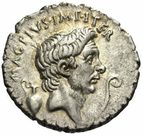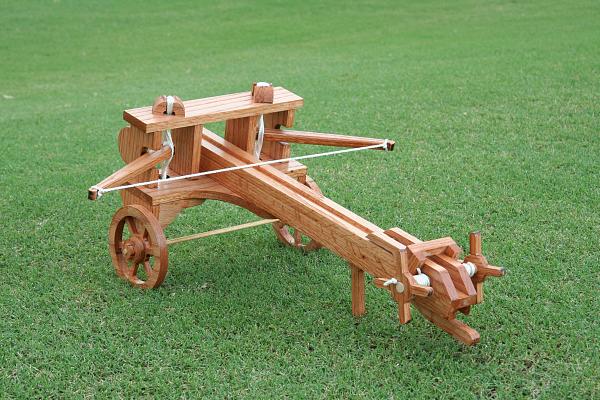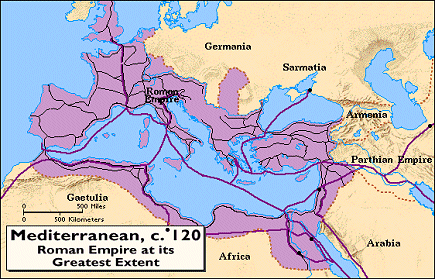Roman Empire
AGMSPRITE

Silver roman sestertius showing Pompeii
Rome was one of the most powerful civilizations in history. Their geography was a major contributor to their advancement. Since Rome had control over the whole Mediterranean Basin, they were able to trade with North Africa and the Middle East very easily. Also, since most of Europe was made up of plains, it allowed the Romans to build a system of concrete roads, something that was revolutionary and allowed the Romans to tame their geography and use it to their advantage. Also, their roads allowed them to deploy military forces quickly, allowing them to better defend their empire and enforce the laws. The roads were also patrolled by the Roman army, allowing a stable form of trade. Between the Mediterranean Sea and the roads, Rome was able to create a very expansive trade network. This trade network covered the whole expanse of the Roman Empire. This allowed for Rome to have a very large and diverse economy. This is because they were able to trade many different goods such as gemstones, grain, vinegar, and ivory. This variety of goods allowed the Romans to have an economy that flourished since the economy relied on a variety of different goods and not just one central good. Another important part of their economy was that the Empire used a common currency called the Sestertius. This allowed the Roman economy to be unified, even though it was spread over a very large area. The Romans used gold and silver coins, suggesting that they knew how to work metal well and had a large amount of gold and silver at hand in which to make the coins with.
All of this would not have been possible without the strong military that Rome had. Its military was made up of its citizens. This is important because since the army was made up of Roman citizens, mainly property owning farmers, they would be willing to fight. Also, the Roman soldiers were paid by the emperor and also by their conquests. This gave the army a reason to keep fighting and conquering land, thus the Roman Empire was able to become very large and was able to, in turn, develop a large economy. The Roman army was also successful because of the military technology that they had. This included a large crossbow called the Scorpion. They also used different tactics other than the standard hoplite formation. Thus, they were able to be more mobile and, in turn, effective on the battlefield. Although the Romans had a vast and effective array of military technology, the soldiers had to supply their own equipment. Thus, the soldiers took great pride in serving in the military. Their military was also responsible for shaping the Roman religion as well. The Romans were a polytheistic society who based many of their gods off of the Greek ones. They prayed to different gods and each god was responsible for different things. For example, Mars was the god of war and an agricultural guardian. As the Romans would conquer people, they would actually adopt some of their gods. Thus, the Roman military played a part in expanding their religion.
The Roman social structure was more mobile than other civilizations. For example, slaves could free themselves if they acquired enough money and farmers could move up into a higher class as well. The middle and lower classes were called plebeians. Although they had a voice in the government because of the public assembly, the upper class had the most power. For a long time, Rome was a monarchy with a king and two consuls. They also had a Senate, made up of the very wealthy. However, the Empire became too large and it became a dictatorship. This meant that the emperor would hold all of the power.
One of the great achievements that Rome accomplished was trigonometry. This was important because it allowed them to build domed structures like the Pantheon and also aqueducts. Aqueducts were important since they provided running water to cities and water to the farmers away from the cities, making it possible for them to be successful agriculturally. Their agricultural success allowed Rome to create a surplus of food, in turn making them into the large empire that they became. Also, the building of the Pantheon is an example of their religion since it was a temple to the gods. They are also responsible for building the Coliseum. Not only is it an engineering feat, but it shows that there was live entertainment in Rome. This means that the people were able to feel unified and that they were successful enough to have free time to enjoy such things. The Romans were also able to effectively use stone to create art as well. Some of their most famous artwork is mosaic, which uses colored stone or glass to depict scenes from their everyday lives. Also, they were able to create stone sculptures that depicted prominent figures such as emperors and gods. This means that they put a lot of emphasis on their rulers and gods and that they were seen as central figures in their lives. The abundant use of stone for artwork is because Rome is located near the Apennine Mountains.
The culmination of Roman culture, geography, military, economics, and politics allowed Rome to become one of the largest and most important civilization in history.
All of this would not have been possible without the strong military that Rome had. Its military was made up of its citizens. This is important because since the army was made up of Roman citizens, mainly property owning farmers, they would be willing to fight. Also, the Roman soldiers were paid by the emperor and also by their conquests. This gave the army a reason to keep fighting and conquering land, thus the Roman Empire was able to become very large and was able to, in turn, develop a large economy. The Roman army was also successful because of the military technology that they had. This included a large crossbow called the Scorpion. They also used different tactics other than the standard hoplite formation. Thus, they were able to be more mobile and, in turn, effective on the battlefield. Although the Romans had a vast and effective array of military technology, the soldiers had to supply their own equipment. Thus, the soldiers took great pride in serving in the military. Their military was also responsible for shaping the Roman religion as well. The Romans were a polytheistic society who based many of their gods off of the Greek ones. They prayed to different gods and each god was responsible for different things. For example, Mars was the god of war and an agricultural guardian. As the Romans would conquer people, they would actually adopt some of their gods. Thus, the Roman military played a part in expanding their religion.
The Roman social structure was more mobile than other civilizations. For example, slaves could free themselves if they acquired enough money and farmers could move up into a higher class as well. The middle and lower classes were called plebeians. Although they had a voice in the government because of the public assembly, the upper class had the most power. For a long time, Rome was a monarchy with a king and two consuls. They also had a Senate, made up of the very wealthy. However, the Empire became too large and it became a dictatorship. This meant that the emperor would hold all of the power.
One of the great achievements that Rome accomplished was trigonometry. This was important because it allowed them to build domed structures like the Pantheon and also aqueducts. Aqueducts were important since they provided running water to cities and water to the farmers away from the cities, making it possible for them to be successful agriculturally. Their agricultural success allowed Rome to create a surplus of food, in turn making them into the large empire that they became. Also, the building of the Pantheon is an example of their religion since it was a temple to the gods. They are also responsible for building the Coliseum. Not only is it an engineering feat, but it shows that there was live entertainment in Rome. This means that the people were able to feel unified and that they were successful enough to have free time to enjoy such things. The Romans were also able to effectively use stone to create art as well. Some of their most famous artwork is mosaic, which uses colored stone or glass to depict scenes from their everyday lives. Also, they were able to create stone sculptures that depicted prominent figures such as emperors and gods. This means that they put a lot of emphasis on their rulers and gods and that they were seen as central figures in their lives. The abundant use of stone for artwork is because Rome is located near the Apennine Mountains.
The culmination of Roman culture, geography, military, economics, and politics allowed Rome to become one of the largest and most important civilization in history.
Works Cited
Armstrong, Monty. Cracking the AP World History Exam. New York: Random House, 2012. Print.
"Roman Empire." Wikipedia. Wikimedia Foundation, 11 Sept. 2012. Web. 09 Nov. 2012. <http://en.wikipedia.org/wiki/Roman_Empire>.
"THE TWELVE TABLES." THE TWELVE TABLES. N.p., n.d. Web. 09 Nov. 2012. <http://www.csun.edu/~hcfll004/12tables.html>.
"Ancient Roman Art and Architecture." Scholastic, Helping Children Around the World to Read and Learn. N.p., n.d. Web. 09 Nov. 2012. <http://www.scholastic.com/browse/article.jsp?id=3753873>.
"The Roman Empire, C125 AD." The Roman Empire, C125 AD. N.p., n.d. Web. 09 Nov. 2012. <http://people.hofstra.edu/geotrans/eng/ch2en/conc2en/romannet.html>.
"The Roman Military." The Roman Military. N.p., n.d. Web. 09 Nov. 2012. <http://romanmilitary.net/>.
"Roman Social Class and Public Display." Roman Social Class and Public Display. N.p., n.d. Web. 09 Nov. 2012. <http://www.vroma.org/~bmcmanus/socialclass.html>.
"10 Cool Engineering Tricks the Romans Taught Us." HowStuffWorks. N.p., n.d. Web. 09 Nov. 2012. <http://science.howstuffworks.com/engineering/structural/10-roman-engineering-tricks.htm>.
"Mosaic." Wikipedia. Wikimedia Foundation, 11 July 2012. Web. 09 Nov. 2012. <http://en.wikipedia.org/wiki/Mosaic>.
"Roman Empire." Wikipedia. Wikimedia Foundation, 11 Sept. 2012. Web. 09 Nov. 2012. <http://en.wikipedia.org/wiki/Roman_Empire>.
"Roman Empire." Wikipedia. Wikimedia Foundation, 11 Sept. 2012. Web. 09 Nov. 2012. <http://en.wikipedia.org/wiki/Roman_Empire>.
Strayer, Robert W. Ways of the World: A Brief Global
History. Boston, MA: Bedford/St. Martin's, 2009. Print.
"Ancient Roman Art and Architecture." Scholastic, Helping Children Around the World to Read and Learn. N.p., n.d. Web. 09 Nov. 2012. <http://www.scholastic.com/browse/article.jsp?id=3753873>.
"The Roman Empire, C125 AD." The Roman Empire, C125 AD. N.p., n.d. Web. 09 Nov. 2012. <http://people.hofstra.edu/geotrans/eng/ch2en/conc2en/romannet.html>.
"The Roman Military." The Roman Military. N.p., n.d. Web. 09 Nov. 2012. <http://romanmilitary.net/>.
"Roman Social Class and Public Display." Roman Social Class and Public Display. N.p., n.d. Web. 09 Nov. 2012. <http://www.vroma.org/~bmcmanus/socialclass.html>.
"10 Cool Engineering Tricks the Romans Taught Us." HowStuffWorks. N.p., n.d. Web. 09 Nov. 2012. <http://science.howstuffworks.com/engineering/structural/10-roman-engineering-tricks.htm>.
"Roman Empire." Wikipedia. Wikimedia Foundation, 11 Sept. 2012. Web. 09 Nov. 2012. <http://en.wikipedia.org/wiki/Roman_Empire>.
"THE TWELVE TABLES." THE TWELVE TABLES. N.p., n.d. Web. 09 Nov. 2012. <http://www.csun.edu/~hcfll004/12tables.html>.
"Ancient Roman Art and Architecture." Scholastic, Helping Children Around the World to Read and Learn. N.p., n.d. Web. 09 Nov. 2012. <http://www.scholastic.com/browse/article.jsp?id=3753873>.
"The Roman Empire, C125 AD." The Roman Empire, C125 AD. N.p., n.d. Web. 09 Nov. 2012. <http://people.hofstra.edu/geotrans/eng/ch2en/conc2en/romannet.html>.
"The Roman Military." The Roman Military. N.p., n.d. Web. 09 Nov. 2012. <http://romanmilitary.net/>.
"Roman Social Class and Public Display." Roman Social Class and Public Display. N.p., n.d. Web. 09 Nov. 2012. <http://www.vroma.org/~bmcmanus/socialclass.html>.
"10 Cool Engineering Tricks the Romans Taught Us." HowStuffWorks. N.p., n.d. Web. 09 Nov. 2012. <http://science.howstuffworks.com/engineering/structural/10-roman-engineering-tricks.htm>.
"Mosaic." Wikipedia. Wikimedia Foundation, 11 July 2012. Web. 09 Nov. 2012. <http://en.wikipedia.org/wiki/Mosaic>.
"Roman Empire." Wikipedia. Wikimedia Foundation, 11 Sept. 2012. Web. 09 Nov. 2012. <http://en.wikipedia.org/wiki/Roman_Empire>.
"Roman Empire." Wikipedia. Wikimedia Foundation, 11 Sept. 2012. Web. 09 Nov. 2012. <http://en.wikipedia.org/wiki/Roman_Empire>.
Strayer, Robert W. Ways of the World: A Brief Global
History. Boston, MA: Bedford/St. Martin's, 2009. Print.
"Ancient Roman Art and Architecture." Scholastic, Helping Children Around the World to Read and Learn. N.p., n.d. Web. 09 Nov. 2012. <http://www.scholastic.com/browse/article.jsp?id=3753873>.
"The Roman Empire, C125 AD." The Roman Empire, C125 AD. N.p., n.d. Web. 09 Nov. 2012. <http://people.hofstra.edu/geotrans/eng/ch2en/conc2en/romannet.html>.
"The Roman Military." The Roman Military. N.p., n.d. Web. 09 Nov. 2012. <http://romanmilitary.net/>.
"Roman Social Class and Public Display." Roman Social Class and Public Display. N.p., n.d. Web. 09 Nov. 2012. <http://www.vroma.org/~bmcmanus/socialclass.html>.
"10 Cool Engineering Tricks the Romans Taught Us." HowStuffWorks. N.p., n.d. Web. 09 Nov. 2012. <http://science.howstuffworks.com/engineering/structural/10-roman-engineering-tricks.htm>.


